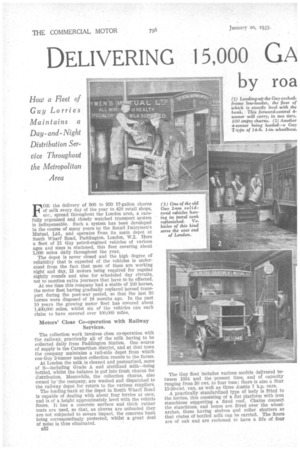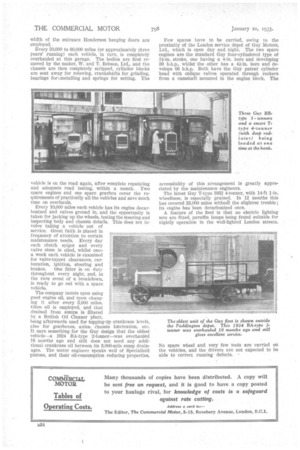DELIVERING 15,000 GA LONS OF
Page 46

Page 47

Page 48

If you've noticed an error in this article please click here to report it so we can fix it.
MILK DAILY
by roa motors
FOR the delivery of 900 to 950 17-gallon churns of milk every day of the year to 420 retail shops, etc., spread throughout the London area, a carefully organized and closely watched transport system is indispensable. Such a system has been developed in the course of many years by the Retail Dairymen's Mutual, Ltd., and operates from its main depot at South Wharf Road, Paddington, London, W.2. Here a fleet of 21 Guy petrol-engined vehicles of various ages and sizes is stationed, this fleet covering about 1,000 miles daily throughout the year.
The depot is never closed and the high degree of reliability that is expected of the vehicles is understood from the fact that most of them are working night and day, 13 motors being required for regular nightly rounds and nine for scheduled day circuits, not to mention extra journeys that have to be effected.
At one time this company had a stable of 100 horses, the motor fleet having gradually replaced horsed transport during the post-war period, so that the last 30 horses were disposed of 18 months ago. In the past 10 years the growing motor fleet has covered about 1,400,000 miles, whilst six of the vehicles can each claim to have covered over 100,000 miles.
Motors' Close Co-operation with Railway Services.
The collection work involves close co-operation with the railway, practically all of the milk having to be collected daily from Paddington Station. One source of supply is the Carmarthen district, and at that town the company maintains a rail-side depot from which one Guy 2-tonner makes collection rounds to the farms.
At London the milk is cleaned and pasteurized, some of it—including Grade A and sterilized milk--being bottled, whilst the balance is put into fresh churns for distribution. Meanwhile, the collection churns, also owned by the company, are washed and dispatched to the railway depot for return to the various suppliers.
The loading bank at the depot in South Wharf Road is capable of dealing with about four lorries at once, and is of a height approximately level with the vehicle floors. It has a concrete surface and thick rubber mats are used, so that, as churns are unloaded they are not subjected to severe impact, the concrete bank being correspondingly protected, whilst a great deal of noise is thus eliminated.
B32 The Guy fleet includes various models delivered between 1924 and the present time, and 0? capacity ranging from 30 cwt. to four tons; there is also a Star 15-20-cwt. van, as well as three Austin 7 h.p. cars.
A practically standardized type of body is fitted to the lorries, this consisting of a flat platform with iron stanchions supporting a fixed roof. Chains connect the stanchions, and boxes are fitted over the wheelarches, these having shelves and roller shutters so that crates of bottled milk can be carried. The floors are of oak and are reckoned to have a life of four years. Each floor is covered with galvanized iron sheeting protected by steel runners.
All but one or two 2-tanners have pneumatic tyres, and no excessive noise is experienced. The solid-tyred vehicles serve mainly the east end of London, where there are narrow back streets with sharp kerbs, etc. The vehicles are allocated to the 13 nightly circuits, according to the quantity of milk taken by each circuit. The 2-toriners convey about 24 churns, whilst the largest 4-tanner (with an arched frame, giving a floor height of only 2 ft. 6 ins.), will carry as many as 44 churns. The following is a list (in brief) of the areas served and the mileages of the nightly rounds :— Hackney (28 miles), Highgate (37 miles), Chelsea ‘38 miles), Streatham (54 miles), Richmond (55 miles), Lewisham (68 miles), City (35 miles), Crouch Hill (49 miles), Kilburn (45 miles), Fulham (42 miles), Aldgate (33 miles), Rotherhithe (54 miles), Mayfair (35 miles).
The vehicles start loading at midnight and turn out at intervals up to about 3 a.m.; they return between 9 a.m. and noon. Niue motors have to be on duty for the rest of the day, four of them on day-time delivery rounds and two on the transport of empties to Bishop's Road railway depot. Additionally, there are cream deliveries, etc., and there is always one van ready at the depot to meet any urgent demand. On Saturday nights an extra heavy delivery takes place, and every vehicle turns out, except the one•which is undergoing its periodical overhaul.
Horsed-transport Men Trained to Operate Motors.
The operation and maintenance of this fleet, which is in the charge of Mr. P. Cashin, involves features of considerable interest. So far as possible, one driver is kept to one van, although, of course, separate drivers take charge in the daytime. Except two of the drivers, all of the men were originally horse carmen and have been successfully instructed in motor work by the company's own staff.
Two ex-stablemen are now engaged continually on oiling, greasing and petrol filling, whilst another attends daily to small body repairs, tyre pressures and other jobs.
A daily report sheet covers the operations of the whole fleet and shows in respect of each vehicle the registration number, the district served, the quantity of petrol required to fill the tank after each journey, the mileage covered, the resultant mileage per gallon of petrol, details of repairs required, and the driver's signature. An additional column is provided for a report upon repairs executed.
The vehicles are washed at the loading depot, much hot water being used, and close by is an underground petrol-storage tank. The garage is at Chilworth Mews, in the locality, and, to obtain full use of the limited width of the entrance Henderson hanging doors are employed.
Every 50,000 to 60,000 miles (or approximately three years' running) each vehicle, in turn, is completely overhauled at this garage. The bodies are first removed by the maker, W. and T. Robson, Ltd., and the chassis are then completely stripped, cylinder blocks are sent away for reboring, crankshafts for grinding, bearings fora metalling and springs for setting. The vehicle is on the road again, after complete repainting and adequate road testing, within a month. Two spare engines and one spare gearbox cover the requirements of practically all the vehicles and save much time on overhauls.
Every 10,000 miles each vehicle has its engine decarbonized and valves ground in, and the opportunity is taken for jacking up the wheels, testing the steering and inspecting body and chassis details. This does not involve taking a vehicle out of service. Great faith is placed in frequency of attention to certain maintenance needs. Every day each clutch spigot and every valve stem is oiled, whilst once a week each vehicle is examined for valve-tappet clearances, carburation, ignition, steering and brakes. One fitter is on duty throughout every night, and, in the rare event of a breakdown. is ready to go out with a spare vehicle.
The company insists upon using good engine oil, and upon changing it after every 3,000 miles. Glico oil is employed, and that drained from sumps is filtered by a British Oil Cleaner plant, being afterwards used for topping-up crankcase levels, also for gearboxes, axles, chassis lubrication, etc. It says something for the Guy design that the oldest vehicle—a 1924 BA-type 2-tonner—was overhauled 18 months ago and still does not need any additional crankcase oil between its 3,000-mile sump drainages. The motor engineer speaks well of Specialloid pistons, and their oil-consumption reducing properties. Few spares have to be carried, owing to the proximity of the London service depot of Guy Motors, Ltd., which is open day and night. The two spare engines are the standard Guy four-cylindered type of 51-in, stroke, one having a 4-in, bore and developing 39 b.h.p., whilst the other has a 41-in, bore and develops 66 b.h.p. Both have the Guy patent cylinder head with oblique valves operated through rockers from a camshaft mounted in the engine block. The accessibility of this arrangement is greatly appreciated by the maintenance engineers.
The latest Guy T-type 1932 4-tonner, with 14-ft 1-in. wheelbase, is especially praised. In 12 months this has covered $3,000 miles withoul the slightest trouble; its engine has been decarbonized once.
A feature of the fleet is that no electric lighting sets are fitted, paraffin lamps being found suitable for nightly operation in the well-lighted London streets.
No spare wheel and very few tools are carried on the vehicles, and the drivers are not expected to be able to correct running defects.




























































































